Lussekatter is the most vital part of a Swedish Christmas! Made in time for Saint Lucia day they're eaten all through the holidays, and usually made in the traditional shape shown here. This is my 100% authentic, tried and tested, all-time best recipe - and it's easy to make without quark and nuts.
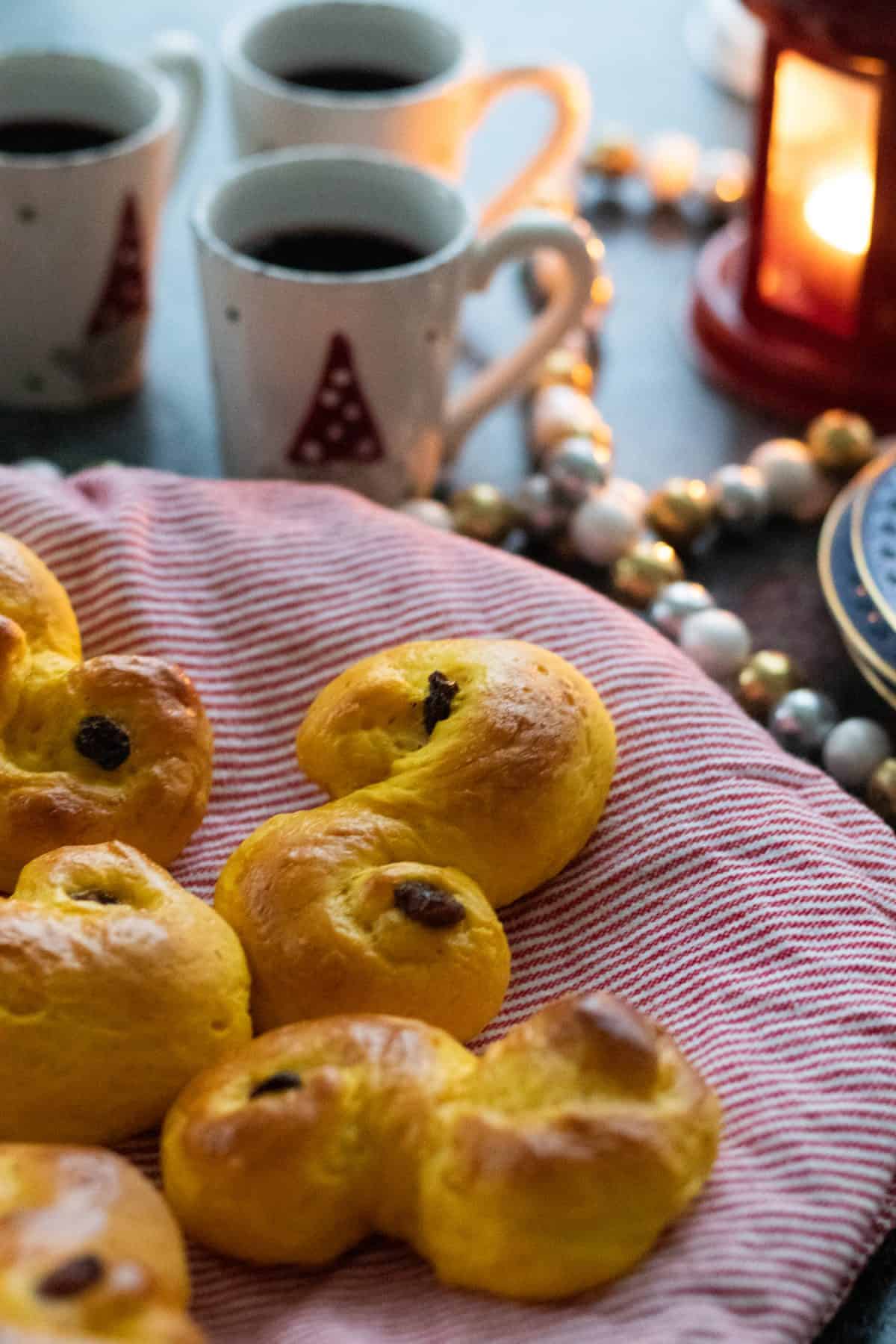
Jump to:
If you ask any Swedish person what they bake for Christmas, the first (and often only) thing almost everyone will answer is Lussekatter.
While important for Christmas, they are vital for St Lucia Day (December 13th) (yep, the same the day we dress up in white night gowns and put candles on our head), and I for one take any chance I get to have one all through December.
Why you will love this recipe
- They're the juiciest, fluffiest Lussekatter I've ever made, or had - and I've tried a lot of different kinds!
- 100% authentic and traditional recipe - made just the way we make them in Sweden, without egg in the dough, pearl sugar, turmeric and other non-traditional ingredients
- So simple to make without extra ingredients such as quark or ground nuts
- They stay fresh for days in room temperature
- Perfectly golden while not overbaked thanks to a lower baking temperature than most recipes
- The best consistency and the best taste, in the easiest way possible - just follow my tips below!
What are Lussebullar or Lussekatter?
Lussekatter - also known as Lussekatts, St Lucia buns, Swedish saffron buns, or saffron bread - is a sweet "bread" made from common ingredients: yeast, flour, sugar, milk and butter. But with the twist that they're seasoned with saffron.
Saffron (or sometimes turmeric if you buy the cheap ones in the store...) is what gives them that beautiful yellow color, and an amazing taste that's rivaled by no other kind of bun.
The shape you see here is the classic one - the name Lussekatter means "Lucia Cats" which come from the way this shape supposedly looks like a cat's tail. If they're homemade, they can however come in many different shapes and sizes.
What you need to make them

Ingredient notes & substitutions
- Milk, yeast and butter should be at room temperature
- Fresh yeast - if you have the choice between regular and one for sweet doughs, use the one for sweet doughs. But both work.
- Instant dry yeast can be used instead of fresh yeast. You then need to adjust the quantity and the process slightly - see instructions below.
- Saffron powder can be used instead of saffron threads. 1 tablespoon of loosely packed saffron threads is equal to about 0.04 oz (1 g) of saffron powder.
- Saffron - if using saffron threads you need to ground them first, using a mortar and pestle or a spoon and a bowl, but I recommend doing this even if you're using ground saffron
- Rum is just used to extract maximum taste from the saffron - you can use vodka, cachaca or brännvin instead, or just water
- Salted butter can be switched for unsalted and a ½ teaspooon of salt
How to make them
30 minutes before baking, you want to start prepping the saffron. Do this by grounding it together with the sugar, using a mortar and pestle or a regular bowl and spoon. Then mix with the rum and set aside for now.

- To make the dough, start by crumbling the yeast into a large bowl - it should be big enough to hold all the ingredients, and for the dough to double in size.
- Pour in milk and mix until the yeast has been dissolved
- Add butter and mix again. Try to smash up the butter a bit, but don't worry if it doesn't dissolve completely into the milk.
- Mix in sugar
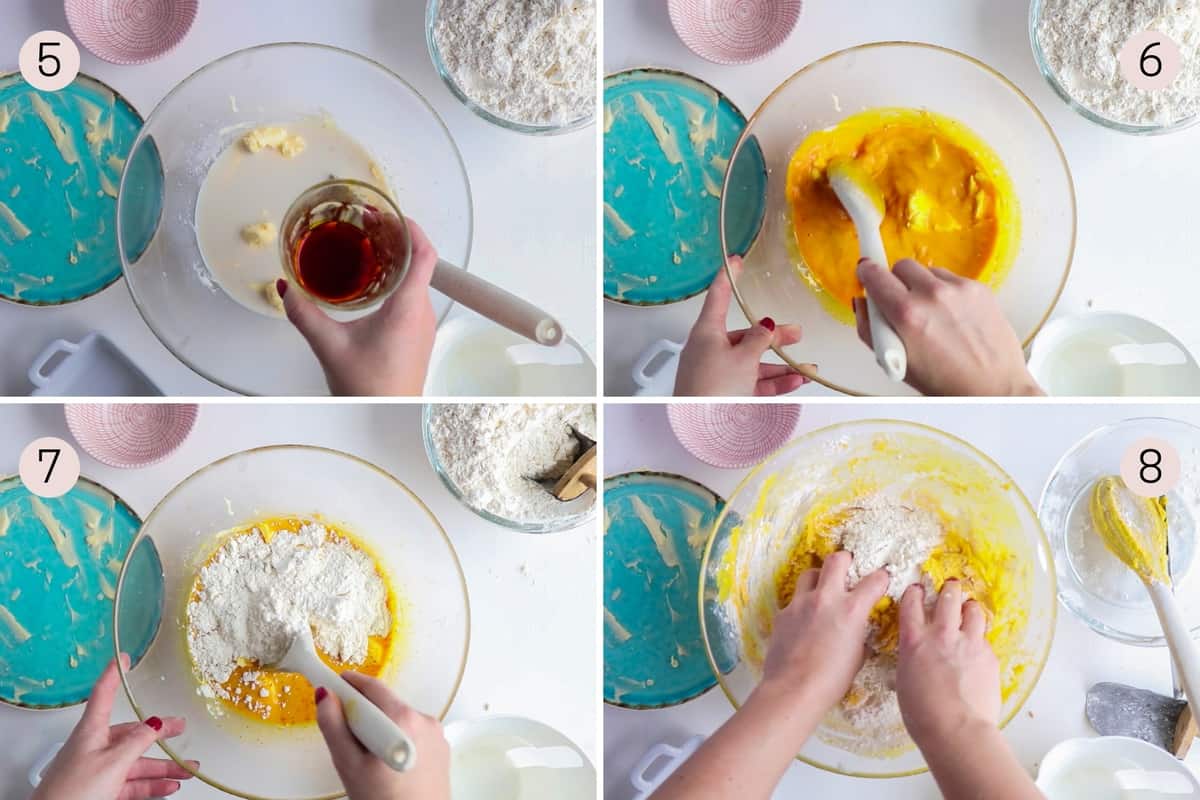
- Pour in the saffron mixed with sugar and alcohol. Then, to ensure you get all that great saffron flavor, pour a small bit of water in the container you had your saffron in, swoosh it around, and pour into the dough.
- Mix - the butter will still not be fully dissolved in the milk
- Start adding flour and mixing. Add a little bit at a time, mix until combined, and then add a bit more. Use a spoon or an electric mixer with dough hooks.
- When it gets hard to mix the dough with a spoon, start using your hands
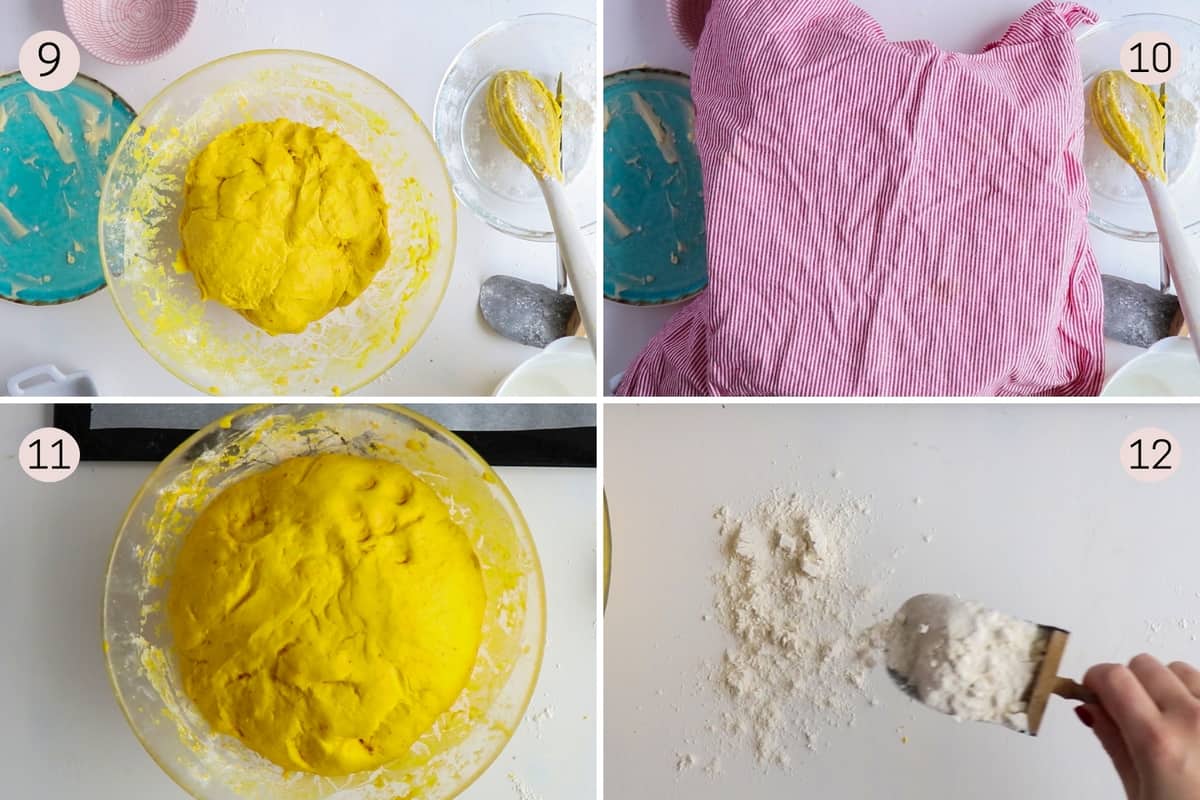
- When all the flour has been added, knead the dough for at least 10 more minutes. When done, it should release easily from the sides of the bowl.
- Cover and set aside to rise for 60 minutes, until doubled in size. Meanwhile, soak the raisins in water and line 2 oven trays with parchment paper.
- After about 60 minutes, the dough should have doubled in sized and feel elastic to the touch. If it hasn't risen enough, give it some more time.
- When the dough has risen enough, pour some flour onto a clean surface

- Take a small piece of dough (one batch of this recipe should make 40 buns) and roll it out on the floured surface
- Roll it into a snake shape that's about 20 cm (8 inches) long
- Then grab each end and slowly turn them in towards each other, but on opposite sides of the dough
- This is the shape you are going for

- Place your lussekatt on one of the oven trays lined with parchment paper, and repeat until the lussekatts are done
- Drain the water from the raisins and place two in each lussekatt - one at the center of each of the spirals
- Cover and set aside to rise again for about 30 minutes, until they're 50% bigger. Meanwhile, preheat the oven to 200° C/400° F.
- Just before baking, whisk the egg and brush the buns with it

- This is what your lussekatter should look like before baking
- Bake in the middle of the oven for 8 minutes, until golden. Depending on your oven, this might take a minut more or less. Then remove from the oven, place on a cooling rack or kitchen towel to cool down and cover with a kitchen towel to keep the moisture in. Repeat until you've baked all the lussekatter!
How to make this recipe with dry yeast
If you use instant dry yeast instead of fresh yeast you will need just ¼ of the quantity stated, in weight. For one batch of this recipe this means 0.5 oz (14 g).
You also need to adjust the proces slightly:
- Mix the instant dry yeast with the flour and let it sit for 10 minutes
- Follow the recipe as written, mixing the milk with the butter, sugar and saffron, and then adding the flour and yeast mixture
The dough can take a little bit longer to rise than when using fresh yeast.
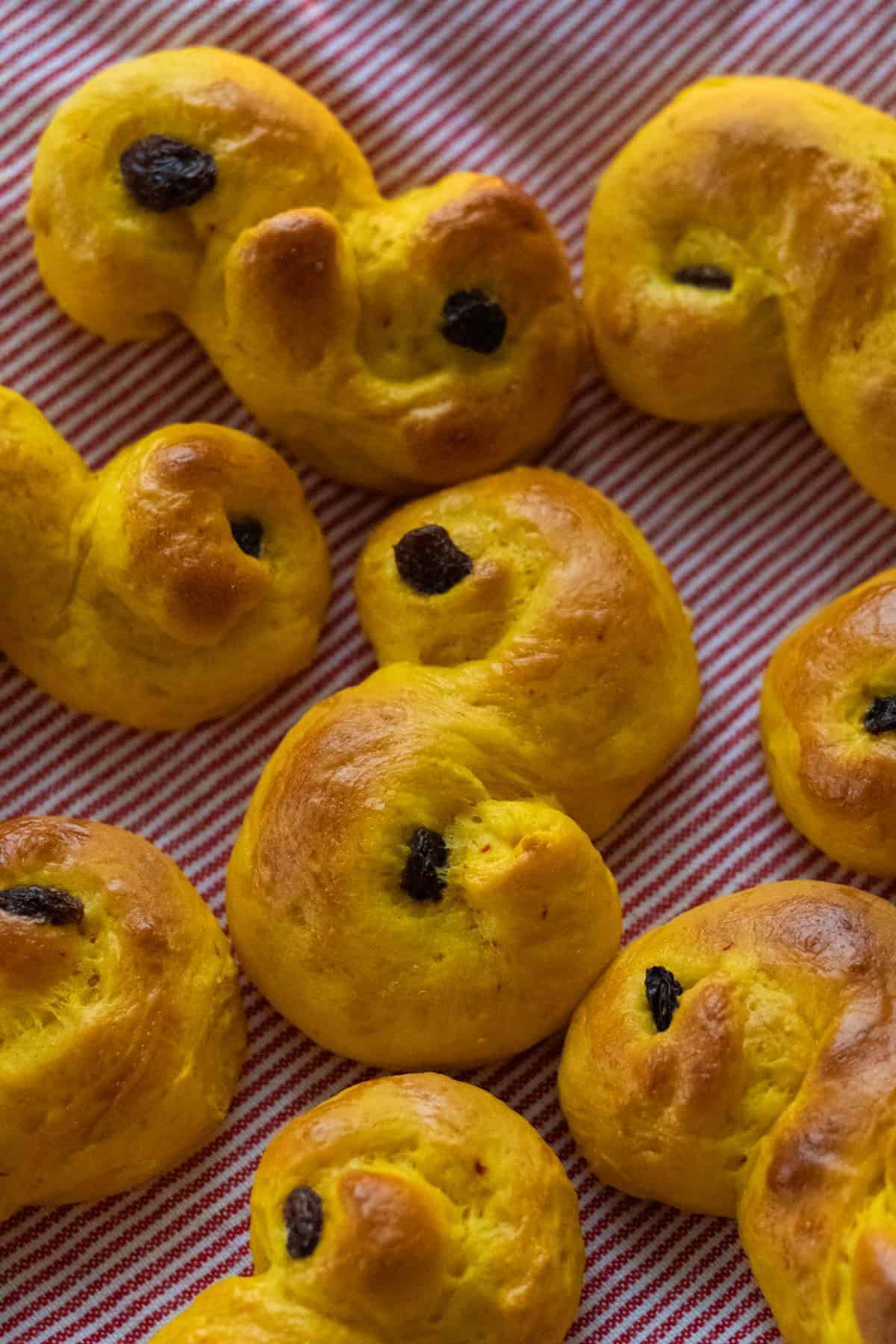
Tips & tricks
- Ground the saffron with sugar - this is especially important if using saffron threads and not already ground saffron
- Extract all the saffron flavor by allowing it to steep in alcohol before adding it to the dough. This way you can use less saffron, but still get a lot of taste.
- Use fresh yeast - dry will work, but fresh rises quicker and better
- Use room temperature butter and milk for the best consistency (instead of melting the butter and heating the milk as many recipes will tell you). Melted butter will absorb a lot of flour which makes your finished buns much dryer.
- Weigh your flour as the density of a cup or deciliter of flour can vary greatly. If you don't have a scale, follow the cups or deciliter measurement instead but be mindful of how the dough feels. When done it should be a bit sticky, but easily release from the sides of the bowl.
- Don't add too much flour as this will make your buns dry. Instead, knead the dough well.
- Knead your dough for at least 10 minutes - this together with the room temperature butter makes all the difference for the softest buns
- Soak your raisins in water first to avoid them soaking up moisture from the dough
- You can also make these into other shapes - in Sweden the second most common shape is to create a large saffron wreath
- Cool on a rack to avoid a soggy bottom
- If you're freezing part of your batch: let them cool down almost fully on the rack and then immediately pack them in bags and stick in the freezer. This ensures you lock as much moisture as possible inside.
- If you don't like saffron, can't find it, or it's just one of those years when it's too expensive - you can use ground turmeric to get that yellow color instead. Or use part saffron, part turmeric. This is what all the cheap bakeries do in Sweden!
- If you don't like raisins, just skip them
- Store Lussekatter in plastic bags in room temperature for up to 4 days - they will go dry before they go bad
- Freeze Lussekatter in plastic bags to store them for longer - up to 3 months - and thaw in room temperature before serving
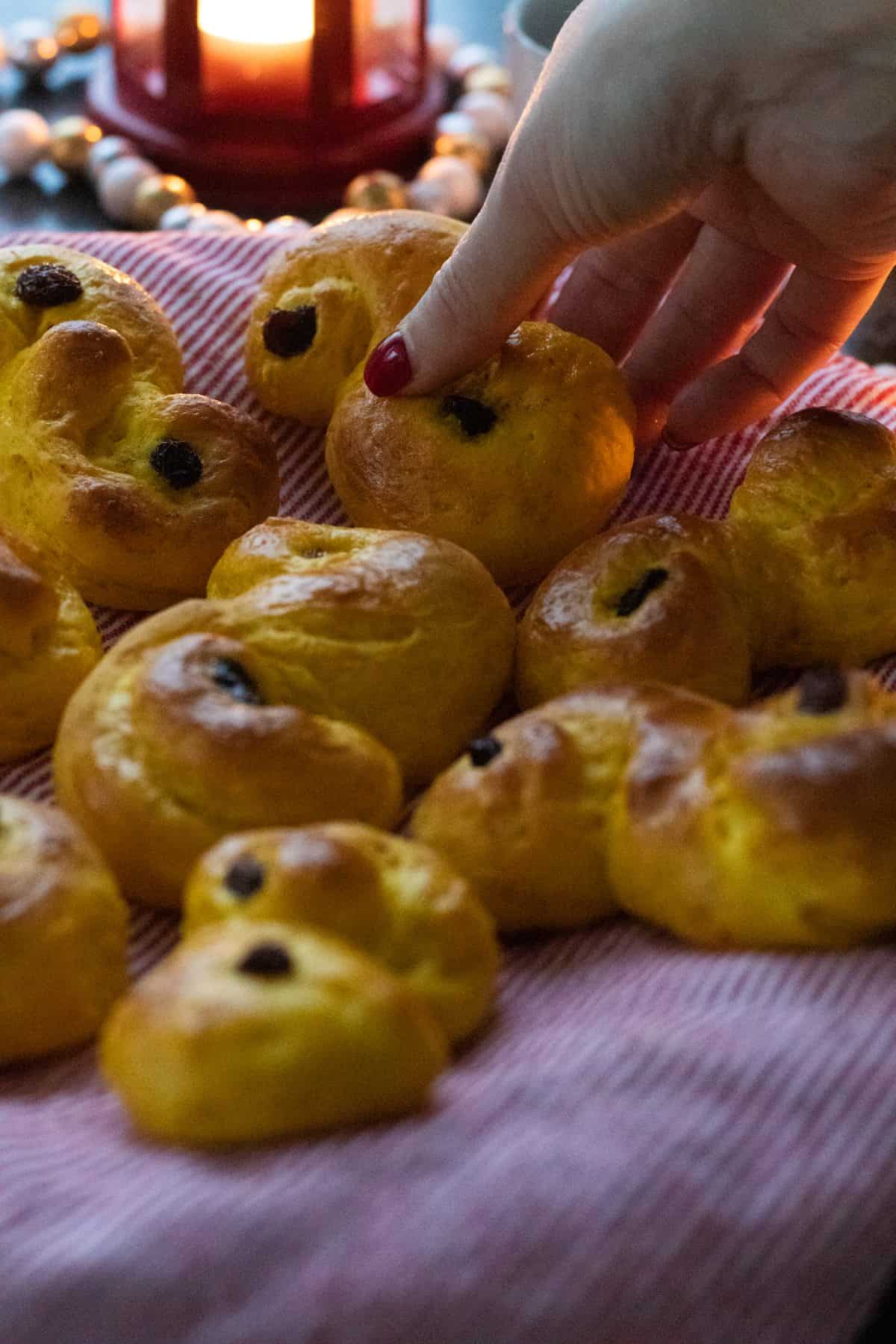
Recipe FAQ
Yes, absolutely - that's what we all do in Sweden. We make a batch in the beginning of December, freeze them, and snack on them all through the Holidays.
Just let them cool down almost fully on the rack, then pack them in plastic bags and freeze. This ensures you lock as much moisture as possible inside.
No, you don't! While the ground almonds is an old trick (that doesn't really make a difference), rumor has it that the quark myth started because the company wanted to sell more of this product...
In reality, the two most important things for really soft and juicy saffron buns are using room temperature butter and kneading the dough for at least ten minutes.
No! The yeast will work fine with room temperature butter and milk as well. It might take a little longer to rise, but the slower rise will actually make both the consistency and taste so much better - and you also don't run the risk of heating your milk & butter too much and "killing" the yeast.
How to serve them
Lussekatter are often served as other "fikabröd" in Sweden - with a cup of coffee.
However, since they are served mainly in December, you will often find them served with a cup of glögg (hot spiced wine) or a glass of Julmust (a very sweet, very delicious, Swedish Christmas soda).
I for one think Lussekatter goes wonderfully with a spicy Christmas Sangria as well...
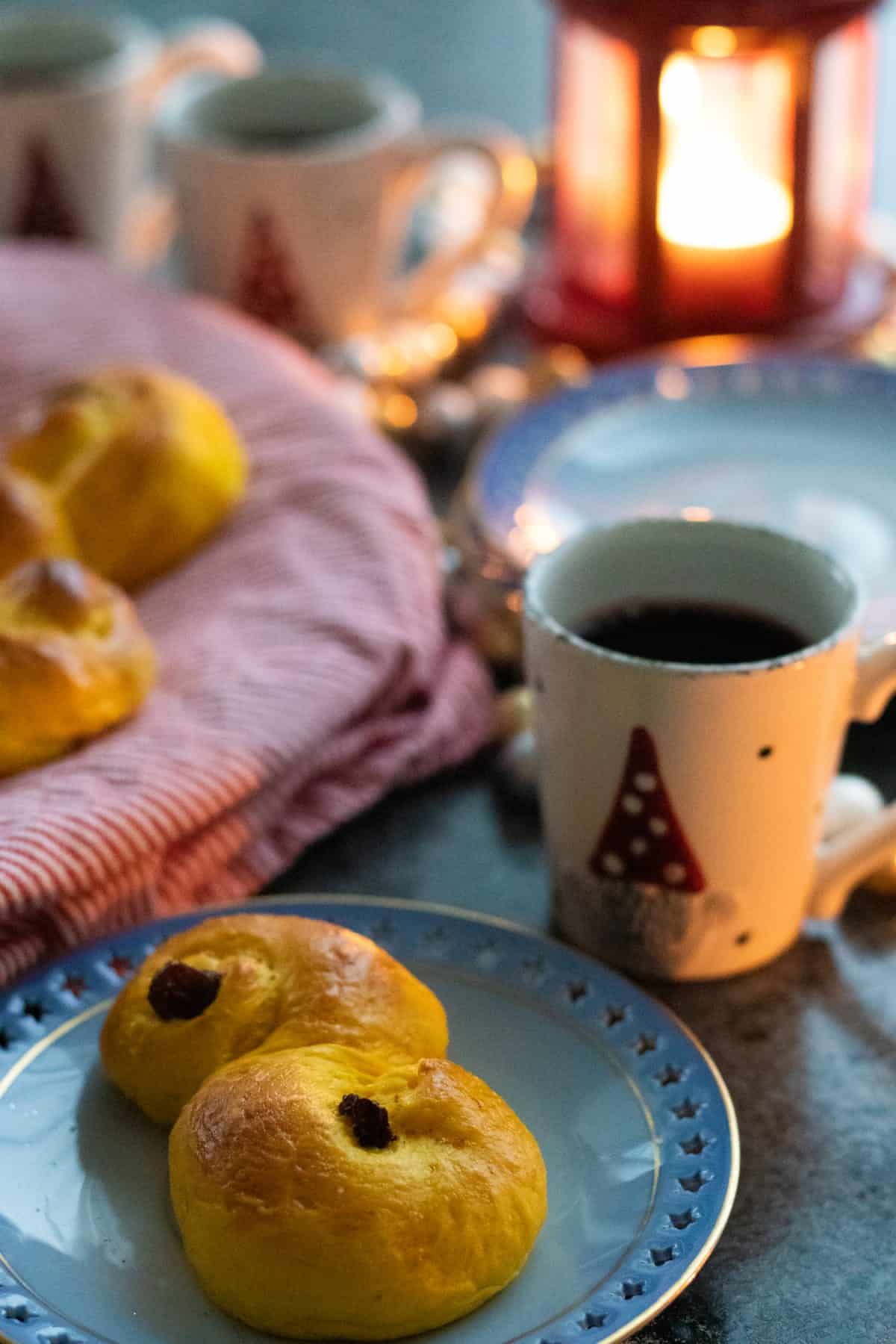
More easy baking recipes for the holidays
Looking for more easy holiday baking recipes?
Did you love this recipe? Rate it five stars!
...and let me know what you loved about it in the comments.
Recipe

Lussekatter
Print RateIngredients
- 1 tablespoon saffron threads loosely packed, see notes for using ground saffron instead
- 1 teaspoon sugar
- 2 tablespoon rum or other alcohol/water
- 1.75 oz fresh yeast room temperature, see notes for using dry yeast instead
- 2.1 cups milk room temperature
- ⅘ cups salted butter room temperature, softened, cut in pieces
- ¾ cups sugar
- 7 cups flour or slightly more or less + more for baking out
- 80 raisins soaked in water
- 1 egg
Instructions
- Start by grounding saffron and sugar with a mortar and pestle, or a bowl and a spoon. Then mix with the rum and set aside for at least 30 minutes.1 tablespoon saffron threads, 1 teaspoon sugar, 2 tablespoon rum
- Crumble the yeast into a large bowl. Add milk, mix, then add in room temperature butter in pieces and mix again, trying to mash up the butter pieces a bit as you go.1.75 oz fresh yeast, 2.1 cups milk, ⅘ cups salted butter
- Mix in sugar and the saffron mixed with sugar and rum. Add a little water to the bowl or glass that held the saffron mix, swoosh it around, and pour in to make sure you get as much of the saffron flavor as possible. Then mix.¾ cups sugar
- Start adding the flour. Add a bit at a time until it is all mixed in. When it's getting hard using a spoon to mix, start using your hands instead.7 cups flour
- When all the flour is added, start kneading the dough. Knead for at least 10 minutes, or longer if you can. When done it should come away easily from the sides of the bowl. Do not add more flour! If it's too sticky, you just haven't kneaded enough. Once done, cover with a kitchen towel and set aside to rise for 60 minutes.
- After 60 minutes, check to see if the dough has risen sufficiently. It should be about double in size. If not, let it rest a bit longer.
- When the dough has risen, place a piece of parchment paper on top of an oven tray. Spread a little flour on a clean surface and take a small piece of dough - enough for one Lussekatt. Roll it out into a 20 cm/7-8'' long snake shape and roll the edges in to create the classic Lussekatt shape (see pictures and detailed instructions in post). Then place on the parchment paper, taking care to space them out so that they have room to rise about 50% more. Continue until you've created all the Lussekatts.
- Drain the raisins and place two in each Lussekatt, one at the middle of each spiral. Then cover with a kitchen towel and set aside for 30 minutes.80 raisins
- Preheat your oven to 400°F (200°C).
- When the Lussekatter have risen by 50%, mix together your egg and remove the kitchen towel. Brush the Lussekatter with the egg.1 egg
- Bake in the middle of the oven for 8 minutes, until golden, then remove and place on a cooling rack or kitchen towel to cool. Cover with a kitchen towel. Repeat until you've baked all your Lussekatter.
Equipment (may contain affiliate links)
- Measuring cups (metric or US)*
Video
Notes
Ingredient notes & substitutions
- Milk, yeast and butter should be at room temperature
- Fresh yeast - if you have the choice between regular and one for sweet doughs, use the one for sweet doughs. But both work.
- Instant dry yeast can be used instead of fresh yeast. You then need to adjust the quantity and the process slightly - see instructions below.
- Saffron powder can be used instead of saffron threads. 1 tablespoon of loosely packed saffron threads is equal to about 0.04 oz (1 g) of saffron powder.
- Saffron - if using saffron threads you need to ground them first, using a mortar and pestle or a spoon and a bowl, but I recommend doing this even if you're using ground saffron
- Rum is just used to extract maximum taste from the saffron - you can use vodka, cachaca or brännvin instead, or just water
- Salted butter can be switched for unsalted and a ½ teaspooon of salt
How to make this recipe with dry yeast
If you use instant dry yeast instead of fresh yeast you will need just ¼ of the quantity stated, in weight. For one batch of this recipe this means 0.5 oz (14 g). You also need to adjust the proces slightly:- Mix the instant dry yeast with the flour and let it sit for 10 minutes
- Follow the recipe as written, mixing the milk with the butter, sugar and saffron, and then adding the flour and yeast mixture
Tips & tricks
- Ground the saffron with sugar - this is especially important if using saffron threads and not already ground saffron
- Extract all the saffron flavor by allowing it to steep in alcohol before adding it to the dough. This way you can use less saffron, but still get a lot of taste.
- Use fresh yeast - dry will work, but fresh rises quicker and better
- Use room temperature butter and milk for the best consistency (instead of melting the butter and heating the milk as many recipes will tell you). Melted butter will absorb a lot of flour which makes your finished buns much dryer.
- Weigh your flour as the density of a cup or deciliter of flour can vary greatly. If you don't have a scale, follow the cups or deciliter measurement instead but be mindful of how the dough feels. When done it should be a bit sticky, but easily release from the sides of the bowl.
- Don't add too much flour as this will make your buns dry. Instead, knead the dough well.
- Knead your dough for at least 10 minutes - this together with the room temperature butter makes all the difference for the softest buns
- Soak your raisins in water first to avoid them soaking up moisture from the dough
- You can also make these into other shapes - in Sweden the second most common shape is to create a large saffron wreath
- Cool on a rack to avoid a soggy bottom
- If you're freezing part of your batch: let them cool down almost fully on the rack and then immediately pack them in bags and stick in the freezer. This ensures you lock as much moisture as possible inside.
- If you don't like saffron, can't find it, or it's just one of those years when it's too expensive - you can use ground turmeric to get that yellow color instead. Or use part saffron, part turmeric. This is what all the cheap bakeries do in Sweden!
- If you don't like raisins, just skip them
- Store Lussekatter in plastic bags in room temperature for up to 4 days - they will go dry before they go bad
- Freeze Lussekatter in plastic bags to store them for longer - up to 3 months - and thaw in room temperature before serving
Nutrition
Nutritional information is approximate and automatically calculated, and should only be viewed as an indication.






Sophia
Hi Emmeline,
Is full fat milk milk best for this recipe?
Also is the oven temperature for a fan assisted oven?
Thanks,
Emmeline Kemperyd
Hi Sophia,
I usually use milk with 1.5% fat, but really any kind works. Just use what you have! I've made it with everything from 0.1% milk to full fat.
Oven temperature is for a regular oven. For a fan assisted oven I think you can drop the temperature to about 360 F or 180 C, but I haven't tested it myself.
/Emmeline
Sophia
Thanks Emmeline.
Also which type of flour do you use?
Thanks.
Emmeline Kemperyd
Oh I just use regular all-purpose flour. Keeping it simple 😉
Sophia
Great, thanks for the quick replies, will attempt to make over the weekend:-)
Maria Giovanna
Hi Emmeline I just discovered your fantastic Lussekatter recipe. It look so easy but I wonder if I could use the Kenwood Mixer (has 800 Watts) because I have hard time kneading the dough the way it should be done.
If it's possible: at what speed and for how long?? I really want to make this recipe. Hope you'll have the time to answer me, meanwhile I thank you in advance and wish you a good life
Maria G.
Emmeline Kemperyd
Hi Maria,
Super excited for you to try the Lussekatter recipe! I always knead the dough in a machine, so I think that sounds like a great idea, as long as you have a dough hook attachment. I'm not 100% sure about the speed for your specific brand though. I use a Bosch that I think has 1000 W, and if usually just adjust the speed so that it looks like it gets the work done. I think I usually end up on one of the higher speeds. So I say try, and see what speed you end up with! The important thing is that it really works the dough, not exactly at what speed.
Hope it turns out well for you, and please come back and let me know how you liked it!
Emmeline
Julie D Blankenship
Trying this recipe for a friend... need some help...
2.1 cups of milk... how much is that?
.75 cups of sugar?
.8 cups of butter?
Thanks!
Emmeline Kemperyd
Hi Julie! I updated the recipe a bit now.
.75 cups = 3/4 cups
.8 cups = 4/5 cups
2.1 cups is 1 cup + 2 tablespoon (sorry, my recipe card will not let me input it this way)
(If what you were looking for was a translation to the Metric system, you can just click the label that says "Metric" just below the ingredient list)
Hope that helps - please let me know otherwise and I will try to help you further!
Emmeline
Jen Paulson
Thank you for the great detailed recipe! While giving away a box of baking related items to my community recently, I asked people to share treats they liked to bake and/or eat this time of year. The man I gave the box to said he baked Lussekatter every December. My husband has Sweedish ancestory so I thought it would be fun to give it a try. This must be a year that saffron is expense! I got about half a tablespoon for $30 USD! A quick Google search and I discovered Saffron Crocus grow in my area. Merry Christmas to me, I'll be ordering some bulbs shortly bawahahah.
I used 50g of fresh sourdough starter and I think they came out great. I have most of them cooling covered on the rack right now with the last batch in the oven. I found I had to bake them 16 minutes until the bottoms were browned - my tops didn't get toasty but maybe my googly eye didn't put the rack in the center slot. I got 41 from my batch. Next year I'll soak the raisins in spiced rum (or egg nog hmmm)!
Emmeline Kemperyd
Thank you for the comment & review Jen! So happy to hear they turned out well for you! And soaking the raisins in rum or egg nog sounds like an amazing idea - might borrow that 😉
Interesting with the baking time. Mine are always done after 8, or a maximum of 9 minutes, and while it depends on the oven 16 minutes does sound long. Mine don't get browned on the bottom though - they're a little bit browned on the top, but not a lot.
David
Hi Emmeline,
Great recipe, thanks.
Just a lil request. Could you give quantities in gr for European readers. (0.8 cups of butter ???) Tack!
david
Oooopsss! Just saw the possibility to have it in metric system. My bad.
Paula
Where did you find the possibility to have it in metric system please?
I have the same question.
Emmeline Kemperyd
Hi Paula! Below the list of ingredients there's a link that says "Metric" - if you click this you will get all the measurements in metric instead. I included them for you below as well if that's not working.
▢½ Tbsp saffron
▢1 tsp sugar
▢2 Tbsp rum or other alcohol/water
▢50 g fresh yeast room temperature
▢500 ml milk room temperature
▢200 g salted butter room temperature, cut in pieces
▢150 g sugar
▢1000 g flour or slightly more or less + more for baking out
▢80 raisins soaked in water
▢1 egg
Paula
Thank you 🙏
Danielle
This recipe looks lovely! Unfortunately I couldn’t follow it because I couldn’t find fresh yeast anywhere in my city. Your recipe says I can use dry but doesn’t give the measurements. $20 on saffron I am afraid to take the chance. Would love to see an updated recipe that includes this substitute. 🙂
Emmeline Kemperyd
Hi Danielle! I am so sorry about that. I can understand your hesitation - saffron is expensive!! Thanks for your suggestion, I agree - it should be included. I added a note about it now - maybe it's too late for you this year, but hopefully it can help someone else (or maybe you want to try this recipe another time). Have a great holiday season! Emmeline
Emmeline Kemperyd
Good you found it, David! Hope you enjoy 🙂
film
I truly appreciate this blog post. Really looking forward to read more. Really Great. Jerrylee Winny Hege
film
This is my first time go to see at here and i am genuinely pleassant to read all at one place. Arabele Igor Gerkman
Monika
What is the best way to reheat these after they are frozen?
Emmeline Kemperyd
Hi Monika! The best way for me is to let them thaw in room temperature, it only takes a few hours. If you're in a hurry I'd recommend either the oven on low heat or microwave on low effect. Just keep in mind they will reheat quickly, so a few minutes in the oven or 15-20 seconds in the microwave will often do!
Beth
I've never heard of this Swedish holiday but it sounds delicious! I love learning new recipes and where they come from so thank you for sharing this one!
Emmeline Kemperyd
Such an interesting holiday - especially since from the outside it probably looks veeery weird but for us it's just standard, haha!
Heather
Hi!
The recipe lists the amount of flour in cups but then recommends weighing it out with a scale (and which I prefer to do). But the amount in grams is not given. Could you list the recommended amount if flour in grams as well as cups?
Thanks! Heather
Heather
Nevermind, I saw the metric conversion feature! My apologies!
kim
This was fabulous and so fun and festive for the holidays! I will definitely make again!
Emmeline Kemperyd
Thank you Kim! Happy to hear you liked it!
Heidy L. McCallum
I love this recipe and I love how you have made it so easy to follow by adding images and specific instructions!
Emmeline Kemperyd
Thank you Heidy!
Pam
I wasn't familiar with these tasty buns, but I love learning about food traditions from different parts of the world!
Emmeline Kemperyd
Same here, so I thought it was about time I shared some of my country's traditions 🙂
Laura Lynch
I've never had these before but was looking for something fun and new to make as a Christmas treat. I love the bright yellow color of the dough and, as you said, butter makes everything amazing.
Emmeline Kemperyd
Thank you for the comment Laura - hope you try them!
Love Keil
Wow, Emmeline! These buns look absolutely delicious. I love how you created step by step images, it is super helpful & makes it easy to follow. Thank you for sharing this yummy recipe!
Emmeline Kemperyd
Thank you so much for commenting!